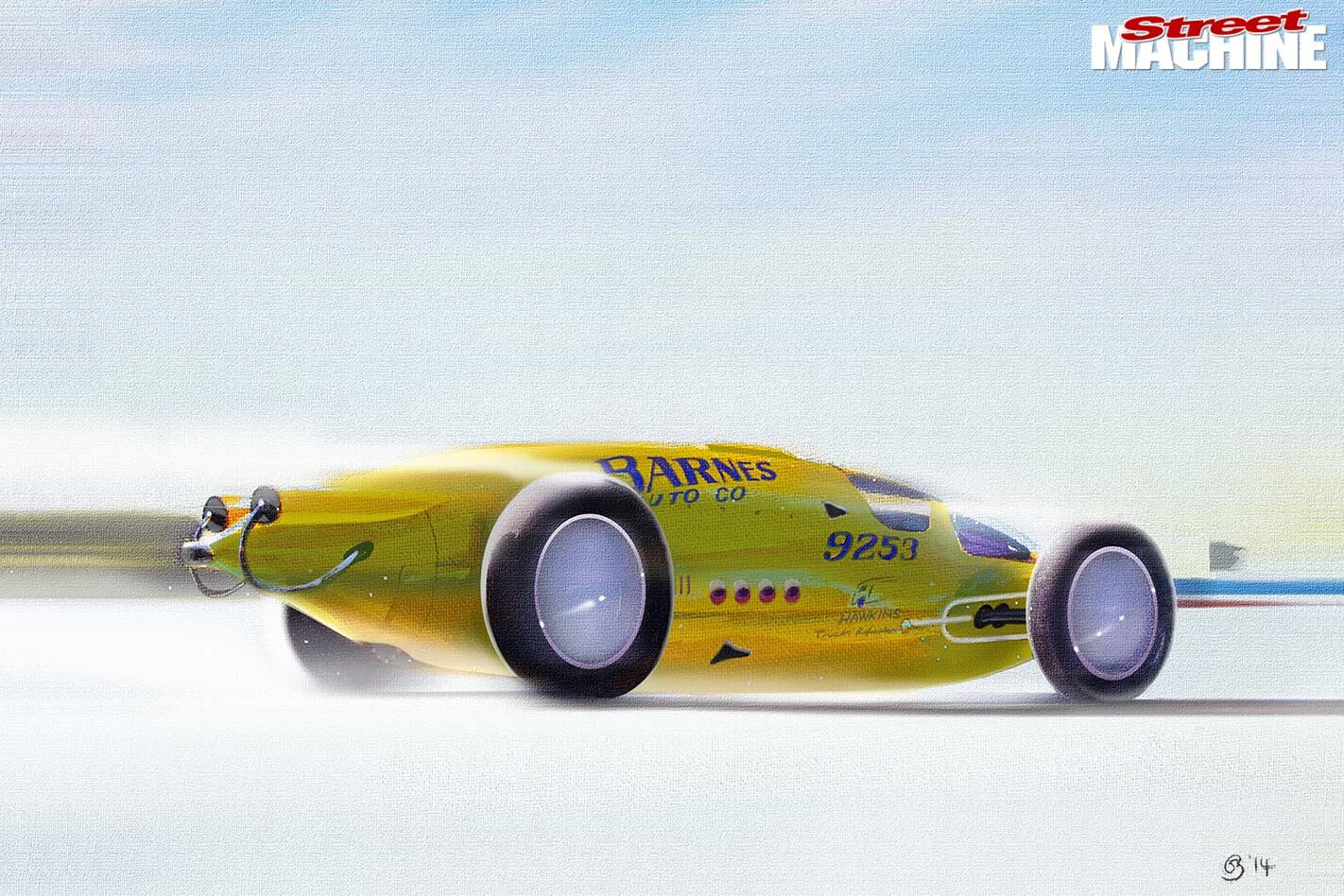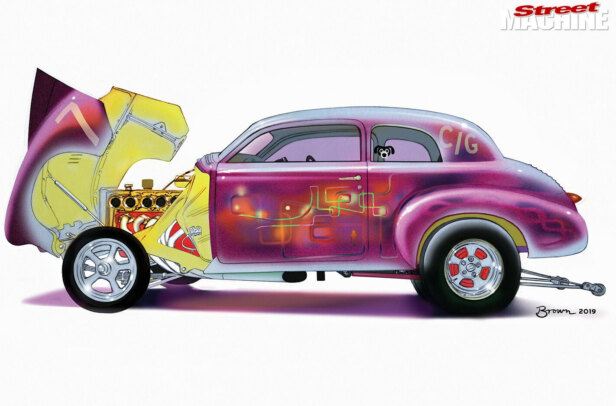GROWING up in Tea Tree Gully on the outskirts of Adelaide in the 70s is not the kind of environment you would expect to produce an artist with so much passion and such a broad interest in all areas of automotive art. Whether it be a speedcar sideways and flicking up dirt, a dry lakes racer at speed or a cool custom just parked on the side of the road, Steve Brown has a distinct but varied style. By his own admission, he went a little bit off the rails as a youth — but just like any other type of artist — if you had a straight up and stable upbringing, what stories would you have to tell? Steve’s got a shit load, and they’re all great.
This article was first published in Street Machine’s Hot Rod magazine #13, 2014
“I don’t work in factories now. After yet another shitty interview, miles from home, I sat in the gutter and painted this. Yet again, the Holden was substituted for Don Garlit’s drag ‘T’, which for some reason was my inspiration that day.”
What was it that tweaked your interest as a kid?
“It was really humble stuff that would make an impression. You would think it was really radical if a car had a certain sticker on the window and if it had a set of reversed rims, that was really amazing.”
“Chopped is one of my favourite shows. Last year, between several commissions, I found Anthony and Hayden’s roasters in this composition, which I painted of my own volition.”
I imagine Tea Tree Gully wasn’t really a hot bed of hot cars back then?
“It was sort of a back wood. It’s now a city with about a quarter of a million people and I saw all that grow. When I was a kid there were dirt roads and lizards. The hot car scene started off really basic. They were jalopies, not Model T jalopies, but 105 Anglias and FJ Holdens. You’d buy a car just because it had rego on it, then thrash it, when the rego ran out you’d get another one — if you didn’t crash it beforehand.”
No details on this fine Harley sketched on Sunday morning at Chopped ’14
So where did the interest in cars come from?
“I can’t remember how far it goes back, I think it goes way back because I come from a family of drovers and it’s almost like a cellular memory for wheels or hooves. I can never remember a time I didn’t like cars, my first word was aeroplane, not Mum or Dad! My grandfather used to take us to the airport when he was minding us, just to get us out of the house. It was good in the old days, it was all open, you could almost walk out to the runway.
“I dragged this canvas up the hill at Collingrove and let fly. First I took thumbnail sketches in the pits. I then took in as much as I could as Michael made each pass. At one stage I spilt paint over the work and had to act fast, creating a violent show for passing patrons. This is what I walked off the hill with. Car is the Kevin Shearer Ford Special, now raced under son Michael’s custody.”
You just got back from DLRA Speed Week, how was that?
“There is a lot of aircraft influence in my artwork, in the conceptual stuff I do and I really loved the lakes because a lot of the aeronautical stuff seems to filter over into the salt lake world.”
“I need to do more watercolour. I was working as a chemical handler when I painted this. I’d knock off and sit in the car, painting, listening to Port Power football news. In this painting I substituted a chopped ’50 Ford for the Holden which was parked there.”
Were there ever hot cars in your family?
“Not really. My grandfather was the first person ever to own a car in our family and that was an FB Holden. No one had hot cars until me and my brother, but we had a neighbour [Colin] and we were really friendly with him, he was an exec at Holden’s. He’d always bring home whatever was the coolest Holden, so he’d bring home XU-1s, GTRs, Monaros, so we had this sneak peak of what was really cool at Holden’s during the muscle car era. The whole muscle car thing was pretty huge when I was a kid. When you’re nine or 10 years old, things form in your mind strongly, you’re very impressionable. We used to race around on pushbikes imitating muscle cars because that’s all we could do.
“This represents many hours of work as part of a digital rendition of the Keally Bros./Mantzaris ‘Rhapsody in Blue’ ’32 Ford show roadster. This was the first show rod I saw at the age of 10. The old Adelaide shows always had the headline cars near the entrance. It was always a thrill, and eagerly anticipated.”
A lot of your art now is focussed on hot rods and customs, when did that kick in?
“When I was about 10 my parents divorced and we hung around Colin a bit at that time and we’d go to the speedway. He was an ex-speedway monkey on a sidecar, he didn’t race any more, but he would take us to Rowley Park. We’d all go down there and it was massive, it was one of the coolest speedways in Australia, right in the middle of Adelaide in the suburbs. The last meeting was in ’79, I was there!
Adelaide was a really strong Super Modified town, they were V8s and the closest thing to hot rods, so you’ve got these big bellowing things racing around. The local hero was Bill Wigzell, he used to drive this thing called ‘Suddenly’ and it was just a legend, man. It was 1970-71 and this thing had an L88 427 big-block in it that was Hilborn injected! For its time it was a monster.”
“Painted on-site during a wet winter night. This work employs an illustrative technique whereby the ’32 Ford is worked into the composition using passing traffic as reference.
So when did you start drawing pictures of cars?
“I can remember my dad drawing a truck once, when I was really little I was sitting on his lap and he’s drawing on this piece of paper. He drew a horizontal line across the paper, then he put a box at one end of the line, then he put three circles under the line, and straight away it became this abstract symbol of a truck. I must have been about three years old. Apparently I was a bit of a graffiti-ist before that, I used to paint with jam on the walls. I always had the compulsion to make marks.
In primary school I used to sit with a mate and during lunch times we wouldn’t even go outside and play. He was into the speedway too, so we’d draw a track on the paper and he’d draw an FB Holden — we knew all the car models, we knew them all — and then I would draw a Mark 3 Zephyr beating his FB, then it would be his turn again.”
“Gerald Clancy had me paint at Chopped ’14. This took several attempts, and the crowd, colour and dust of Chopped made me think of India.”
At what point did you realise that it was something you wanted to do?
“I never got to that point. I got pretty wild as a teenager, my whole life has been off the rails really. I’ve had a pretty checkered and wild life and as far as a career goes, I never developed one. I was an art school dropout, I came sixth highest in the state for art in high school but I came second last in my school for my matriculation. We had a really good art department at high school and I developed a lot of good skills. After that I just bumped around from thing to thing.
I found the drags when I was a teenager and that really turned me on. Once I heard a drag engine, that was it. The first meet I went to was the ’77 Nationals at AIR. I still remember the first drag car I ever saw, it was the Theuma & Leake Monaro. I was like: ‘F**kin’ hell, man, What the f**k! Look at that! Listen to that!’
I was starting to get into punk rock and hanging out with bad cats and here’s this engine that sounds angrier, tougher, bigger, meaner than anything I’ve ever heard. It just blew me away.”
“This Falcon follows up on a theme first rendered by me in biro in 1980 and published by Eddie Ford that year. There, I had a flathead Ford in a ’69 Camaro.”
So it was a case of; F**k the Sex Pistols, I’m going drag racing!
“Exactly! [laughs] I did end up going into music, someone dragged me into this band and I did that for about 10 years. I was the singer, I was hopeless too, but I worked on it. I wasn’t naturally talented — still aren’t — but I went to a singing teacher and he straightened me out. Ended up in an R&B/Funk sort of thing.”
Steve starts everything with pencil and does 80-90 per cent of the painting in the field, on the spot. Depending on whether it’s a commission or not, he might tidy it up on Photoshop once he’s back in the studio.
Was there a point when someone wanted to give you money for your art?
“I used to swap drawings of cars at high school for lunch money. I’d want to go and buy some chips. People would come up and say: ‘Can you do a Bedford van, like the one you did with the Rolls Royce grille on it?’ Yeah, no worries. I’d take orders and do biro sketches. Around the same time I went and saw American Graffiti at the drive-ins with Dad and my brother. Then Happy Days came out and that was cool, so that American culture started to come into sway a bit. American Graffiti was a big influence, that really turned me on to hot rods.”
You stopped drawing for a while, what was the distraction?
“I’ll tell you what happened. I got big time into building model kits, it got obsessive, it was really nuts. It got so bad that it started to cramp my style, that in conjunction with relationship pressures saw me do something pretty crazy. I was spending so much time on these things that I couldn’t see myself ever drawing or painting again. I was almost addicted to it, so the only way I was going to stop it was to smash them all up. And one day I did.
I got my influence off this German artist I once saw on telly. She was very intense and said: ‘The only way sometimes you can break through to something else is you’ve got to destroy what’s already there.’ From that moment I found the HAMB [Steve is Spoggie on the forum] and I found Jeff Norwell and the Friday Art Show and I started to rediscover drawing and painting — I haven’t built a model kit since and I haven’t looked back!”




Comments